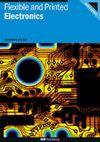用于集成到光电电路板中的柔性印刷聚合物波导
IF 3.2
4区 工程技术
Q3 MATERIALS SCIENCE, MULTIDISCIPLINARY
引用次数: 0
摘要
光电电路板(EOCB)为在高电磁环境中进行短距离数据传输提供了巨大潜力。找到一种仅使用快速成型印刷工艺制造 EOCB 的经济高效的方法,可以在 PCB 系统中建立、增加和保护数据传输。柔版印刷是一种高效的制造工艺,它结合了高轮廓分辨率和布局灵活性来制造光波导。先前的研究表明,在聚甲基丙烯酸甲酯基板上印刷波导可实现长达 20 厘米的光数据传输。然而,要将印刷波导集成到印刷电路板中,需要一种耐热聚酰亚胺(PI)基板。由于聚酰亚胺不符合光学要求,波导芯必须用印刷光学包层隔开。本研究旨在研究增材印刷工艺,该工艺将各种聚合物堆叠在一起,以实现可随时集成的波导。此外,还根据光学结构的功能测试验证了 PCB 中的集成。本研究介绍了印刷 EOCB 的整个制造过程,从而能够在即将开展的研究中对光学耦合过程进行调查。本文章由计算机程序翻译,如有差异,请以英文原文为准。
Flexo-printed polymer waveguides for integration in electro-optical circuit boards
Electro-optical circuit boards (EOCBs) offer great potential for short-ranged data transmission in highly electro-magnetic inflicted environments. Finding a cost-efficient way to manufacture EOCB only using additive printing processes could establish, increase, and secure data transmission in PCB systems. Flexo printing is an efficient manufacturing process that combines high contour resolution and layout flexibility to create optical waveguides. Previous research has shown that printing waveguides on a polymethylmethacrylate substrate can enable optical data transmission for up to 20 cm. However, a thermo-resistant polyimide (PI) substrate is needed to integrate printed waveguides into PCB. Since PI does not meet optical demands, waveguide cores must be separated by printed optical cladding. This research aims to investigate the additive printing process, which stacks various polymers to achieve waveguides that are ready for integration. Further, the integration in PCB is validated according to functional testing of the optical structures. An entire manufacturing process for printed EOCB is presented, which enables the investigation of optical coupling processes in upcoming research.
求助全文
通过发布文献求助,成功后即可免费获取论文全文。
去求助
来源期刊

Flexible and Printed Electronics
MATERIALS SCIENCE, MULTIDISCIPLINARY-
CiteScore
4.80
自引率
9.70%
发文量
101
期刊介绍:
Flexible and Printed Electronics is a multidisciplinary journal publishing cutting edge research articles on electronics that can be either flexible, plastic, stretchable, conformable or printed. Research related to electronic materials, manufacturing techniques, components or systems which meets any one (or more) of the above criteria is suitable for publication in the journal. Subjects included in the journal range from flexible materials and printing techniques, design or modelling of electrical systems and components, advanced fabrication methods and bioelectronics, to the properties of devices and end user applications.
 求助内容:
求助内容: 应助结果提醒方式:
应助结果提醒方式:


